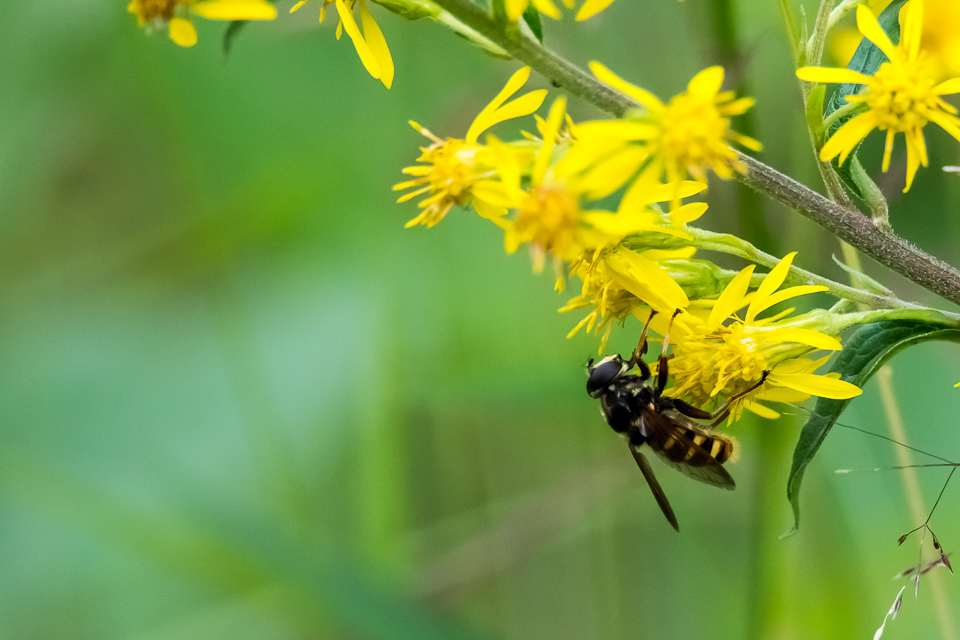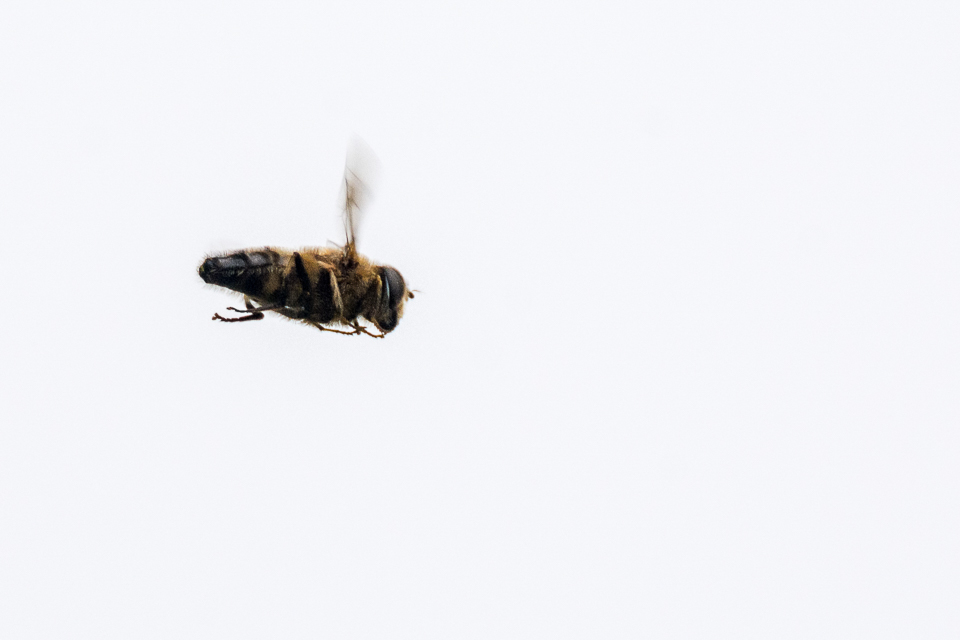-
Bog hoverfly
Sericomyia silentis, is a species of hoverfly. It is widespread throughout Britain and Europe but normally encountered in small numbers in boggy locations. -
Bumblebee hoverfly
Volucella bombylans is larger than most hoverflies, reaching a body length of 11 to 17 mm. and a wingspan length of 8–14 mm.[3] They look something like a bumblebee with a furry black, yellow and/or white body, but they are given away by their heads, plumed antennae,[2] large eyes and the particular wing venation, which make them quite easy to identify as a true fly, like a blowfly. -
Common banded hoverfy
Syrphus ribesii is a very common Holarctic species of hoverfly. Its larvae feed on aphids. In common with many other species of hoverfly, males have the eyes meeting on the top of the head, whilst females have their eyes widely separated. -
Dead head fly
Myathropa florea is a very common European and North African species of hoverfly. Adults may be seen on flowers from May to September. It is of similar size as the drone fly, but living Myathropa are generally more yellow, with two light bands to the thorax, interrupted with a black central smudge. In museum specimens, any yellow colour soon fades to brown after death. Like most Eristalini, Myathropa are rather variable in size, shape and colour. Larvae feed on bacteria in organic waterlogged detritus, often in the shallow rot holes of tree stumps. -
Drone fly
Eristalis tenax is common, migratory and cosmopolitan, the most widely distributed syrphid species in the world, and is known from all regions except the Antarctic. It has been introduced into North America and is widely established. It can be found gardens and fields all over both Europe[2] and Australia,[3] but have also been found all the way up in the Himalayas. -
Epistrophe melanostoma
Epistrophe melanostoma -
Epistrophe grossulariae
Habitat is deciduous woodland, particularly along rivers and streams, Salix swamp woodland, alpine grassland. Found in clearings, tracksides and beside streams. Flowers visited include white umbellifers, Centaurea, Cirsium, Filipendula, Geranium, Knautia, Rhododendron, Rubus, Sambucus nigra, Succisa, Valeriana. The flight period is end June to September. The larva feeds on aphids. -
Eristalis horticola
Eristalis horticola is a Palearctic species of hoverfly. Th especie ha no common name -
Eristalis intricarius
Eristalis intricarius is a European species of hoverfly. It is a furry bee mimic, superficially resembling Merodon, though Merodon have all black leg tibiae, as opposed to partly yellow. E. intricarius is somewhat variable in colour pattern, and some attempts at naming varieties have been tentatively made. Flight time of adults in the UK are from March to September. It is generally widespread, but is seldom seen in large numbers. Habitat is woodland or marshland. The specie has no common name. The larve is commonly know as rat-tailed larve. -
Eupeodes latifasciatus
Eupeodes latifasciatus is a species of hoverfly. Adults feed on nectar; larvae feed on aphids and scale insects. -
Large tiger hoverfly
Large tiger hoverfly
The scientific genus name is composed of the parts helos (ἕλος, gr.), meaning "marsh" and philos (φίλος, gr.) meaning "friend". The species name is composed by "tri" (lat.), meaning "three" and "vitta" (lat.) meaning "band". This name refer to the preference of these insects for moist areas and to the fact that they carry three stripes on the breast shield. -
Long hoverfly
Sphaerophoria scripta can reach a length of 7–12 millimetres (0.28–0.47 in) and a wingspan of 5–7 mm.[3] Body is long and narrow, with yellow and black bands. The wings are transparent. Antennae are short and yellow. The face is yellow. Thorax is a bit dull, copper colored with broad yellow side stripes. Scutellum is yellow. Abdomen is long and cylindrical with four wide, yellow transverse bands. The legs are yellow. Females are brighter than the males. In the males the last two bands are often blurred. -
Marmelade hoverfly
Episyrphus balteatus, sometimes called the marmalade hoverfly, is a relatively small hoverfly (9–12 mm) of the Syrphidae family, widespread throughout the Palaearctic region, which covers Europe, North Asia and North Africa. The upper side of the abdomen is patterned with orange and black bands. Two further identification characters are the presence of secondary black bands on the third and fourth dorsal plates and faint greyish longitudinal stripes on the thorax. Its color patterns may appear wasp-like to other animals, such as birds, protecting it from predation. -
Marsh tiger fly
Wing length 8·5-11·25 mm. Femorae 3 top 1/4 or less yellow. Tibiae 3 pale on basal 1/4 or less. Males tergite 2 large yellow spotsreach the hind margin over their full width. The larva is illustrated by Hartley (1961). -
Melanostoma scalare
Little is known of its biology. However it is suspected to be general predator of small insects in leaf litter. Adults fly from April to November and inhabit gardens, meadows and flowering bushes where they feed. The larvae are aphidiphagous. -
Pellucid fly
Volucella pellucens (also called the Pellucid Fly) is a hoverfly. It occurs in much of Europe, and across Asia to Japan.
It is about 15–16 mm in length with a broad body. It is mainly black, but the front part of its abdomen has a broad, yellow band, giving it the appearance of a bee or wasp. The two wings are transparent, as with most flies, but the leading edge is amber, with a brown patch on each wing.
The mimicry of bees or wasps in shape, and colouration is shown by other hoverflies, and this is thought to protect against falling prey to birds and other insectivores which avoid eating true wasps because of their stings. However, the difference between hoverflies and wasps or bees is hoverflies have two wings, and the Hymenoptera species have four.
The adult V. pellucens is usually found in woodlands, but will enter gardens. It lives on nectar and pollen, as with most hoverflies, and visits flowers from May to October, showing a distinct preference for bramble. It typically flies at head height. -
Plain-faced dronefly
Eristalis arbustorum is a European species of hoverfly. The size of the coloured patches on the abdomen varies with larval rearing temperature, as does wing length. They are attracted to the flowers of cow parsley, common hogweed, creeping thistle, knapweed and common yarrow. -
Pyrophaena granditarsa
Pyrophaena granditarsa is a species of hoverfly. It is found in many parts of Britain and Europe. Typical habitat includes marshy meadows and ditches, where it can be found between May and October, though it is at its commonest between July and September. The most distinctive feature of this fly is the red-orange abdomen most easily seen as it takes off or alights. No common name -
Scaeva selenitica
Scaeva selenitica can reach a length of 12–15 millimetres (0.47–0.59 in), with a wing length of 10.5–12 millimetres (0.41–0.47 in). These large distinctive hoverflies have sparse, fine light hair. Thorax is shiny black, scutellum is yellowish-green and the abdomen is dark black, The legs are light brown-yellow in the middle, while femurs and feet are darker. The abdomen shows three pairs of yellow comma markings (lunules). This species is similar to Scaeva pyrastri but differs in that the abdomen markings are larger and yellow, while in Scaeva pyrastri they are white -
Sun fly
Helophilus pendulus is a European hoverfly. Its scientific name means "dangling marsh-lover" (from Greek helo-, "marsh", -phil, "love", Latin pend-, "hang"). It is a very common species in Britain, where it is the commonest Helophilus species; it occurs as far north as the Shetland Islands. It is also found in Ireland. It also has the common name sun fly, although this is probably based on a mis-reading of helo- as heli. -
Syrphus torvus
Syrphus torvus is a common species of hoverfly found in the Holarctic. The adults feed on pollen and nectar, but the larvae feed on aphids. -
Tapered dronefly
Eristalis pertinax is a European hoverfly. Like Eristalis tenax, the larva of E. pertinax is a rat-tailed maggot and lives in drainage ditches, pools around manure piles, sewage, and similar places containing water badly polluted with organic matter. -
Vagrant Hoverfly
Eupeodes corollae is a very common European species of hoverfly. Adults are 6–11 millimetres (0.24–0.43 in) in body length. Males and females have different marking on the abdomen; males have square commas on tergites 3 and 4, whereas females have narrow commas. Larvae feed on aphids. This species has been used experimentally in glasshouses as a method of aphid control, and to control scale insects and aphids in fruit plantations. They were found to be partial to the fruit, eating more fruit than aphids. -
Xylota segnis
The genus name Xylota is the Latinized form of the rare Byzantine-Greek ξυλωτή [xsylōtē] meaning wooden, while the Latin species name segnis means slipping or lazy, as this hoverfly usually rests on a leaf and it does not fly frequently. The translation of the taxon could be "lazy wood fly".























